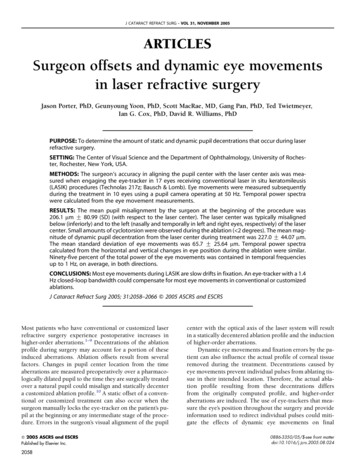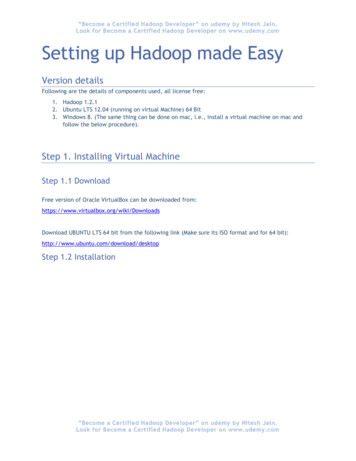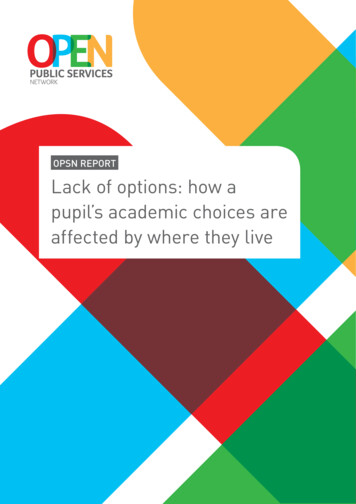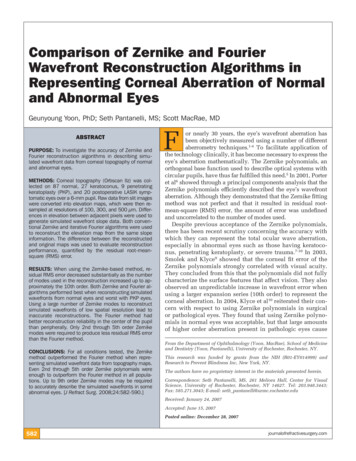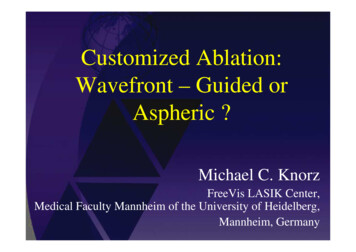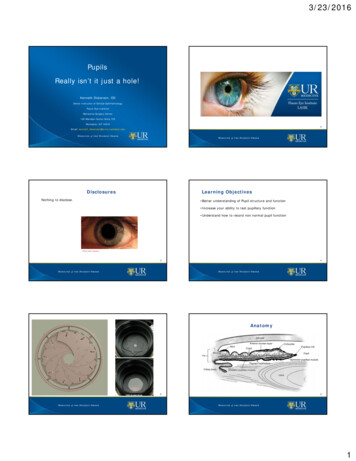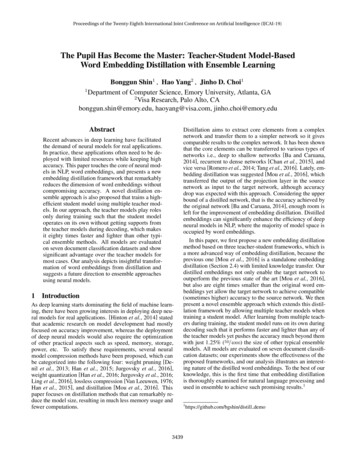
Transcription
Proceedings of the Twenty-Eighth International Joint Conference on Artificial Intelligence (IJCAI-19)The Pupil Has Become the Master: Teacher-Student Model-BasedWord Embedding Distillation with Ensemble LearningBonggun Shin1 , Hao Yang2 , Jinho D. Choi11Department of Computer Science, Emory University, Atlanta, GA2Visa Research, Palo Alto, CAbonggun.shin@emory.edu, haoyang@visa.com, jinho.choi@emory.eduAbstractRecent advances in deep learning have facilitatedthe demand of neural models for real applications.In practice, these applications often need to be deployed with limited resources while keeping highaccuracy. This paper touches the core of neural models in NLP, word embeddings, and presents a newembedding distillation framework that remarkablyreduces the dimension of word embeddings withoutcompromising accuracy. A novel distillation ensemble approach is also proposed that trains a highefficient student model using multiple teacher models. In our approach, the teacher models play rolesonly during training such that the student modeloperates on its own without getting supports fromthe teacher models during decoding, which makesit eighty times faster and lighter than other typical ensemble methods. All models are evaluatedon seven document classification datasets and showsignificant advantage over the teacher models formost cases. Our analysis depicts insightful transformation of word embeddings from distillation andsuggests a future direction to ensemble approachesusing neural models.1IntroductionAs deep learning starts dominating the field of machine learning, there have been growing interests in deploying deep neural models for real applications. [Hinton et al., 2014] statedthat academic research on model development had mostlyfocused on accuracy improvement, whereas the deploymentof deep neural models would also require the optimizationof other practical aspects such as speed, memory, storage,power, etc. To satisfy these requirements, several neuralmodel compression methods have been proposed, which canbe categorized into the following four: weight pruning [Denil et al., 2013; Han et al., 2015; Jurgovsky et al., 2016],weight quantization [Han et al., 2016; Jurgovsky et al., 2016;Ling et al., 2016], lossless compression [Van Leeuwen, 1976;Han et al., 2015], and distillation [Mou et al., 2016]. Thispaper focuses on distillation methods that can remarkably reduce the model size, resulting in much less memory usage andfewer computations.3439Distillation aims to extract core elements from a complexnetwork and transfer them to a simpler network so it givescomparable results to the complex network. It has been shownthat the core elements can be transferred to various types ofnetworks i.e., deep to shallow networks [Ba and Caruana,2014], recurrent to dense networks [Chan et al., 2015], andvice versa [Romero et al., 2014; Tang et al., 2016]. Lately, embedding distillation was suggested [Mou et al., 2016], whichtransferred the output of the projection layer in the sourcenetwork as input to the target network, although accuracydrop was expected with this approach. Considering the upperbound of a distilled network, that is the accuracy achieved bythe original network [Ba and Caruana, 2014], enough room isleft for the improvement of embedding distillation. Distilledembeddings can significantly enhance the efficiency of deepneural models in NLP, where the majority of model space isoccupied by word embeddings.In this paper, we first propose a new embedding distillationmethod based on three teacher-student frameworks, which isa more advanced way of embedding distillation, because theprevious one [Mou et al., 2016] is a standalone embeddingdistillation (Section 2.4) with limited knowledge transfer. Ourdistilled embeddings not only enable the target network tooutperform the previous state of the art [Mou et al., 2016],but also are eight times smaller than the original word embeddings yet allow the target network to achieve compatible(sometimes higher) accuracy to the source network. We thenpresent a novel ensemble approach which extends this distillation framework by allowing multiple teacher models whentraining a student model. After learning from multiple teachers during training, the student model runs on its own duringdecoding such that it performs faster and lighter than any ofthe teacher models yet pushes the accuracy much beyond themwith just 1.25% (50/4000) the size of other typical ensemblemodels. All models are evaluated on seven document classification datasets; our experiments show the effectiveness of theproposed frameworks, and our analysis illustrates an interesting nature of the distilled word embeddings. To the best of ourknowledge, this is the first time that embedding distillationis thoroughly examined for natural language processing andused in ensemble to achieve such promising results.11https://github.com/bgshin/distill demo
Proceedings of the Twenty-Eighth International Joint Conference on Artificial Intelligence (IJCAI-19)(a) Logit Matching (Sec. 2.1)(b) Noisy Logit Matching (Sec. 2.2)(c) Softmax Tau Matching (Sec. 2.3)Figure 1: Three teacher-student methods described in Background section, which uses different cost functions to transfer trained knowledgefrom the teacher model to the student model.2BackgroundOur embedding distillation framework is based on teacherstudent models [Ba and Caruana, 2014; Sau and Balasubramanian, 2016; Hinton et al., 2014], where teacher models aretrained on deep neural networks and transfer their knowledgeto student models on simpler networks. The following subsections describe three popular teacher-student methods appliedto our framework. The main difference between these threemethods is in their cost functions (Figure 1). The last subsection discusses embedding encoding that is used to extractdistilled embeddings from the projection layer.Throughout this section, a logit refers to a vector representing the layer immediately before the softmax layer in aneural network, where zi and vi are the teacher’s and student’slogit values for the class i, respectively. Note that the studentmodels are not necessarily optimized for only the gold labelsbut also optimized for the logit values from the teacher modelsin these methods.2.1Logit Matching (LM)Proposed by [Ba and Caruana, 2014], the cost function ofthis teacher-student method is defined by the logit differencesbetween the teacher and the student models (D: the totalnumber of classes):D1 XLLM zi vi 22 · D i 12.2Noisy Logit Matching (NLM)Proposed by [Sau and Balasubramanian, 2016], this methodis similar to Logit Matching except that Gaussian noise isintroduced during the distillation, simulating variations in theteacher models, which gives a similar effect for the student tolearn from multiple teachers. The cost function takes randomnoise η drawn from Gaussian distribution such that the logitof each teacher model is zi0 (1 P η) · zi . Thus, the final cost102function becomes LN LM 2D i zi vi .2.3Softmax Tau Matching (STM)Proposed by [Hinton et al., 2014], this method is based on softmax matching where softmax values are compared betweenthe teacher and the student models instead of logits. Later,[Hinton et al., 2014] added two hyperparameters to furthergeneralize this method. The first hyperparameter, λ, is forthe weighted average of two sub-cost functions, where thefirst sub-cost function measures a cross-entropy between the3440student’s softmaxP predictions and the truth values, representedas L1 i yi log pi (i indexes classes, y is the gold label, pi (0, 1) is the prediction for a sample). Another costfunction involves the second hyperparameter, τ , that is a temperature variable normalizing the output of the teacher’s logitvalue:ezi/τsi (z, τ ) PD zj/τj 1 eGivenP si , the second cost function can be defined as L2 i si (z, τ ) log pi . Therefore, the final cost function becomes LST M λL1 (1 λ)L2 . If λ weights more on L1 ,the student model values more on the gold labels than teacher’spredictions. If τ is greater, the teacher’s output becomes moreuniformed, implying that the probability values are spread outmore throughout all classes.2.4Embedding Encoding (ENC)Embedding distillation was first proposed by [Mou et al.,2016] for NLP tasks. Unlike our framework, their methoddoes not rely on teacher-student models, but rather directlytrains a single model with an encoding layer inserted betweenthe embedding layer and its upper layer in the network (Figure 2a). Each word wi is entered to an embedding layer φthat yields a large embedding vector φ(wi ). This vector isprojected into a smaller embedding space by Wenc with anactivation function f . As a result, a smaller embedding vector φ0 (wi ) is produced for wi as follows (benc : a bias for theprojection):φ0 (wi ) f (Wenc · φ(wi ) benc )The smaller embedding φ0 (wi ) generated by this projectioncontains distilled knowledge from the larger embedding φ(wi ).The cost function of this method simply measures the crossentropy between gold labels and the softmax output values.3Embedding DistillationOur proposed embedding distillation framework begins bytraining a teacher model using the original embeddings. Aftertraining, the teacher model generates the corresponding logitvalue for each input in the training data. Then, a student modelthat comprises a projection layer is optimized for the logit(or softmax) values from the teacher model. After trainingthe student model, small embeddings are distilled from theprojection layer (Figure 3a).
Proceedings of the Twenty-Eighth International Joint Conference on Artificial Intelligence (IJCAI-19)(a) Embedding distillation.(b) Model deployment.Figure 2: (a) The core elements from large embeddings are distilledduring training using gold labels and transferred to smaller embeddings. (b) Only the small embeddings are kept for the deployment,resulting less space and fewer computations.The original large embeddings as well as weights in the projection layer are discarded for deployment such that the smallembeddings can be referenced directly from the word indicesin the student model during decoding (Figure 3b). Such distillation significantly reduces the model size and computationsin the network, which is welcomed in production.3.1Distillation via Teacher-Student ModelsProjecting a vector into a lower dimensional space generallyentails information loss, although it does not have to be thecase under two conditions. First, the source embeddings comprise both relevant and irrelevant information for the targettask, therefore, there is a room to discard the irrelevant information. Second, the projection layer in the target network iscapable of preserving the relevant information from the sourceembeddings. The first condition is met for NLP because mostvector space models such as Word2Vec [Mikolov et al., 2013],Glove [Pennington et al., 2014], or FastText [Bojanowski etal., 2017] are trained on a vast amount of text, where only asmall portion is germane to a specific task.To meet the second condition, teacher-student models areadapted to our distillation framework, where the projectionlayer in a student model learns the relevant information forthe target task from a teacher model. The output dimensionof the projection layer is generally much smaller than the sizeof the embedding layer in a teacher model. Note that it ispossible to integrate multiple projection layers in a studentmodel; Experiment section discusses performance differenceby adding different numbers of projection layers in the studentmodel.(a) Embedding distillation.(b) Model deployment.Figure 3: (a) Our proposed embedding distillation framework usingteacher-student models. (b) Only the small embeddings are kept fordeployment, similarly to Figure 2b.3441(a) Embedding distill ensemble.(b) Model deployment.Figure 4: (a) Our proposed embedding distillation ensemble model.One representing logit (R. LOGIT) is calculated from a set of multipleteachers’ logits by the proposed ensemble methods. (b) No need toevaluate teachers at deployment, unlike other ensemble methods.3.2Projection Layer InitializationUnlike [Mou et al., 2016] who randomly initialized the projection layer, it is initialized with vectors pre-trained by anautoencoder [Hinton and Zemel, 1994] in our framework. Thisinitialization stabilizes and improves optimization of neuralnetworks during training, resulting more robust models.4Distillation EnsembleEnsemble methods generally achieve higher accuracy than astandalone model; however, slow speed is expected due to theruns from multiple models in ensemble. This section presentsa novel ensemble approach based on our distillation frameworkusing logit matching that produces a light-weighted studentmodel trained by multiple teachers (Figure 4).The premise of this approach is that it is possible to havemultiple teacher models train a student model by combiningtheir logit values such that the student no longer needs theteachers during decoding because it already learned “enough”from them during training. As a result, our ensemble approachensures higher efficiency for the student model than for anyof the teacher models during decoding. The following sections describe two different ensemble methods applied to ourframework.4.1Routing by Agreement Ensemble (RAE)This method gives more weights to the majority, by adoptingthe dynamic routing algorithm presented by [Sabour et al.,2017]. It first collects the consensus of all teachers, thenboosts weights of the teachers who strongly agree with thatconsensus whereas suppresses the influence of the teacherswho do not agree as much. The procedure of calculating therepresenting logit is described in Algorithm 1.The squash function in lines 4 and 9 is a non-linear activation function that ensures the norm of the output vector to bein [0, 1] [Sabour et al., 2017]. This vectorized activation isimportant for a routing algorithm because both magnitude anddirection play an important role in the agreement calculationby the dot product, which enforces the consensus into thedirection with strong confidence.
Proceedings of the Twenty-Eighth International Joint Conference on Artificial Intelligence (IJCAI-19)of embeddings are trained with dimensions of 50 and 400by Word2Vec [Mikolov et al., 2013]. While training, defaulthyper-parameters are used without an explicit hyper-parametertuning.Algorithm 1: Get R. LOGIT for RAE and RDE11Input: Teachers’ logits Z RT C , andan algorithm selector b {RAE, RDE}. Output: The representing logit, z rep RC .k 1 if b is RAE else 1for t {1, . . . , T } doxt squash(z t ), wt 0while n iterations doc softmax(w)PTz rep t 1 ct · z ts squash(z rep )if not last iteration thenfor t {1, . . . , T } dowt wt kxt · s12return z rep12345678910DatasetMR [Pang and Lee, 2005]SST-1 [Socher et al., 2013]SST-2 [Socher et al., 2013]Subj [Pang and Lee, 2004]TREC [Li and Roth, 2002]CR [Hu and Liu, 2004]MPQA [Wiebe et al., 8945007172,015Table 1: Seven datasets used for our experiments. C: number of classes, TRN/DEV/TST: number of instances in training/development/evaluation set.4.2 Routing by Disagreement Ensemble (RDE)This method focuses on the minority vote instead, becauseminority opinions may cast important information for the task.The algorithm is the same as RAE, except for the sign of theweight update (line 2 in Algorithm 1).55.1ExperimentsTwo types of teacher models are developed using Convolutional Neural Networks (CNN) and Long Short-Term Memory Networks (LSTM); comparing different types of teachermodels provides more generalized insights for our distillationframework. All teacher models use 400 dimensional wordembeddings, and all student models are based on CNN. TheCNN-based teacher and student models share the followings:filter sizes [2, 3, 4, 5], # of filters 32, dimension of thehidden layer right below the softmax layer 50. Teachermodels add a dropout of 0.8 to the hidden layer, wheres student models add dropouts of 0.1 to both the hidden layer andthe the projection layer. On the other hand, the LSTM-basedteacher models use two bidirectional LSTM layers. Only thelast output vector is fed into the 50 dimensional hidden layer,which becomes the input to the softmax layer. A dropout of0.2 is applied to all hidden layers, both in and out of the LSTM.For both CNN and LSTM ensembles, all 10 teachers share thesame model structures with different initializations. Althoughthis limited teacher diversity, our ensemble method producesremarkably good results (Section 5.7).Each student model may consist of one or two projectionlayers. The one-layered projection adds one 50 dimensionalhidden layer above the embedding layer that transfers coreknowledge from the original embeddings to the distilled embeddings. The two-layered projection comprises two layers;the size of the lower layer is the same as the size of teacher’sembedding layer, 400, and the size of the upper layer is 50,which is the dimension of the distilled embeddings. This twolayered projection is empirically found to be more robust thanvarious combinations of network architectures including widerand deeper layers from our experiments.45.4DatasetsNetwork ConfigurationPre-trained WeightsAll models are evaluated on seven document classificationdatasets in Table 1. MR, SST-*, and CR are targeted at thetask of sentiment analysis while Subj, TREC, and MPQA aretargeted at the classifications of subjectivity, question types,and opinion polarity, respectively. About 10% of the trainingsets are split into development sets for SST-* and TREC, andabout 10/20% of the provided resources are divided into development/evaluation sets for the other datasets, respectively.An autoencoder comprising a 50-dimensional encoder and a400-dimensional decoder is used to pre-train weights for thetwo-layered projection in student models, where the encoderand the decoder have the same and inversed shapes as theupper and lower layers of the projection. Note that resultsby using pre-trained weights for the one-layered projectionare not reported in Table 2 due to the limited space, but weconsistently see robust improvement using pre-trained weightsfor the projection layers.5.25.5Word EmbeddingsFor sentiment analysis, raw text from the Amazon Reviewdataset2 is used to train word embeddings, resulting 2.67Mword vectors. For the other tasks, combined text fromWikipedia and the New York Times Annotated corpus3 areused, resulting 1.96M word vectors. For each group, two setsSix models are evaluated on the seven datasets in Table 1 toshow the effectiveness of our embedding distillation framework: logit matching (LM), noisy logit matching (NLM),softmax tau matching (STM) models with T193442Embedding DistillationAmong convolutional, relational, and dense-networks with differentconfigurations, the dense-network with the reported configurationproduces the best results.
Proceedings of the Twenty-Eighth International Joint Conference on Artificial Intelligence (IJCAI-19)ModelENCCNN-400CNN-50LM TSEDNLM TSEDSTM TSEDLM TSED PT 2LNLM TSED PT 2LSTM TSED PT 2LLSTM-400LSTM-50LM TSEDNLM TSEDSTM TSEDLM TSED PT 2LNLM TSED PT 2LSTM TSED PT .11 0.9779.0778.0777.63 0.3778.10 0.4077.81 0.3379.06 0.5978.60 0.7078.77 0.7079.2877.1678.61 0.8078.89 0.7378.85 0.6080.33 0.4079.33 0.6680.09 0.49SST-144.94 1.2649.8645.0748.71 0.7348.66 0.8349.10 0.3449.82 0.5449.90 0.5949.19 0.7149.2343.7648.79 0.2748.81 0.4448.77 0.8349.37 0.3948.87 0.5349.14 0.62SST-283.71 1.4186.2284.5185.04 0.6485.17 0.1684.72 0.7085.75 0.4285.31 0.7585.83 0.5986.2283.3685.81 0.7785.55 0.7486.11 0.3686.12 0.4785.89 0.4386.95 0.44Subj90.64 0.4992.3490.8191.91 0.2992.03 0.3692.25 0.3892.63 0.2392.26 0.2092.38 0.5392.7190.0291.74 0.3691.87 0.3291.99 0.1692.53 0.2992.35 0.1892.34 0.49TREC90.60 1.1093.6091.0092.48 0.7392.36 0.9192.76 0.6592.58 0.8692.80 0.6293.48 0.3092.0086.0092.56 0.8991.80 1.2992.36 0.4391.91 0.6392.08 0.4692.96 0.62CR80.88 1.2283.8280.8981.84 0.5783.04 0.7480.31 0.4283.40 0.7683.82 0.4983.57 0.8582.9880.0682.76 0.3682.96 0.5082.96 0.7283.54 0.7883.32 0.6182.73 0.25MPQA88.65 0.6088.7886.4089.14 0.2588.90 0.3489.13 0.2889.44 0.2089.61 0.1489.95 0.2889.7385.6689.59 0.2889.63 0.1089.60 0.1690.15 0.1389.92 0.3589.83 0.30Table 2: Results from our embedding distillation models on the evaluation sets in Table 1 using the CNN-based (the rows 5-10) and theLSTM-based teacher models (rows 13-18) along with the teacher models (*-400), baseline model (*-50) and previous distillation model (ENC).All models are tuned on the development sets and the best performing models are tested on the evaluation sets. Since neural models producedifferent results at any training due to the random initialization, five models are developed for each approach to avoid (un)lucky peaks, exceptfor *-400 and *-50 where the results are achieved by selecting the best models among ten trials on the development sets. Each score is based onthese five trials and represented as a pair of [Average Standard Deviation].Figure 5: Similarity distributions among sentiment word pairs. Blueand Red colors distinguish histograms from the original and distilled embeddings, respectively. The solid and dashed lines showthe distributions from all word pairs regardless of their sentiments.Circles are for sentimentally similar word pairs, that are similarities between positive word pairs and negative word pairs such that(wi , wj ) (P P ) (N N ). Crosses are for sentimentallyopposite word pairs, that are similarities across positive and negativeword pairs such that (wi , wj ) P N .two models highlights the strength of our distilled models,significantly outperforming them with the same dimensionalword embeddings (50-dim).Table 2 shows the results achieved by all models. Whilethe two existing models, *-50 and ENC, show marginal differences, our proposed models, * TSED, outperform the previous embedding distillation SOTA (ENC). Our final models,* PT 2L, outperform all the other models, reaching similar(or even higher) accuracy to the teacher models (*-400), whichconfirms that the proposed embedding distillation frameworkcan successfully transfer the core knowledge from the originalembeddings with respect to the target tasks, independent fromthe network structures of the teacher models.The fact that the best model for each task comes from adifferent teacher-student strategy appears to be random. However, considering that it is the nature of neural network modelswhose accuracy deviates at every training, this is not surprising although it signifies the need of ensemble approaches totake advantage of multiple teachers and produce a more robuststudent model.based embedding distillation (TSED), and another three models with the autoencoder pre-trained weights (* PT) and thetwo layered projection network (* 2L). Teacher models using400-dim embeddings (*-400) are also presented along with thebaseline model using 50-dim word embeddings (*-50) and theprevious distillation model (ENC). The comparison to these34435.6Lexical AnalysisEmbedding distillation for a task such as sentiment analysiscan be viewed as a vector transformation that adjusts similarities between word embeddings with respect to their sentiments.Thus, we hypothesize that distilled word embeddings from sentiment analysis should bring similar sentiment words togetherwhile disperse opposite ones in vector space.To verify this, lexical analysis on both the original and thedistilled word embeddings is conducted using the four sentiment datasets: SST-1, SST-2, MR, and CR. First, positiveand negative words are collected from two publicly availablelexicons, the MaxDiff Twitter Sentiment Lexicon [Kiritchenkoet al., 2014] and the Bing Liu Opinion Lexicon [Hu and Liu,2004]. Then, two groups of sentiment word sets are con-
Proceedings of the Twenty-Eighth International Joint Conference on Artificial Intelligence 0.470Teacher RAE(a) MRRDE0.850Teacher RAE(b) 9100.8200.9200.9000.8100.935Teacher RAE(c) SST-2RDETeacher RAERDETeacher RAE(d) SubjRDE(e) TREC0.9050.9000.8950.890Teacher RAERDE0.885(f) CRTeacher RAERDE(g) MPQAFigure 6: Accuracy comparisons between the ensemble and the teacher models. To avoid (un)lucky peaks, each method is evaluated 20 timeswhere each trial produces a different result. These evaluation results are shown as boxplots in this figure.structed, (Pt , Nt ) and (Po , No ), where P and N composepositive and negative words, and t and o are collected fromthe Twitter and the Opinion lexicons, respectively. Next, theintersection between each type of sentiment word sets is found,that are Pto Pt Po and Nto Nt No , where Pto 72and Nto 89. Finally, the intersections between to and thevocabulary set from each of the four sentiment datasets arefound (e.g., P A Pto , where is one of the four datasetsand A is the set of all words in ): SST1 P 66 and N 83. SST2 P 67 and N 83. MR P 67 and N 82. CR P 19 and N 57.For each , cosine similarities are measured for all possibleword pairs (wi , wj ) P N P N where P N P N , using the original and distilled embeddings. Figure 5illustrates the similarity distributions. It is clear that similarsentiment words generally give high similarity scores with thedistilled embeddings (the plots drawn by red circles), whereasopposite sentiment words give low similarity scores (the plotsdrawn by red crosses). On the other hand, low similarityscores are shown for any case with the original embeddings(the plots drawn by blue circles and crosses). The normaldistributions derived from the distilled embeddings (the redlines) are more symmetric and spread than the ones from theoriginal embeddings (the blue lines), implying that distilledembeddings are more stable for the target task.5.7Distillation EnsembleAll ensemble models are based on our distillation frameworkusing logit matching (LM) where the teacher models composeof 10 CNN-based or 10 LSTM-based models. Two ensemblemethods are evaluated: Routing by Agreement (RAE) andRouting by Disagreement (RDE), and Figure 6 shows comparisons between these ensemble models against the teachermodels.The most notable finding is that RDE significantly outperforms the teacher, if the dataset is big. For example, RDEoutperforms the teacher models on average, except for CR andMPQA, whose training set is relatively small (Table 1). Theinsight behind this trend might be that if there are many datasamples, then the probability of exploring different knowledge from minor opinions could be increased, which wouldpositively affect to the ensemble.3444TrainDeployPreviousO(400M 10)O(400M 10)ProposedO(400M 11)O(50M )Reduction 0.91 80Table 3: The number of neurons in previous ensemble methods andthe proposed distillation ensemble method for training and deploying. M represents the basic unit of model size for the embeddingdimension 1. This table assumes ensemble with 10 teachers.5.8Model ReductionThe deployment models from either distillation or ensembleare notably smaller than the teacher models. Since word embeddings occupy a large portion of neural models in NLP,reducing the size of word embeddings through distillation decreases the size of the entire model roughly by the same ratioas its reduction; in our case, eight times (400/50). Furthermore,if the proposed distillation ensemble method is compared toother typical ensemble methods, this reduction ratio becomeseven larger. Table 3 shows the number of neurons required forprevious ensemble methods and the proposed one. When training, the proposed one comprises 10% more parameters due tothe distillation process. However, when deploying, the reduction of neuron is about eighty times (4000/50). This is becausethe proposed framework doesn’t require repetitive evaluationof teacher models when testing, while other ensemble methodsrequire evaluation of all sub models (teachers).It is worth mentioning that the deployment models producedby distillation ensemble not only outperform the teacher models in accuracy but also are significantly smaller such thatthey operate much faster and lighter than the teacher modelsupon deployment. This is very welcoming for those who wantto embed these models into low-resource platforms such asmobile environments.6ConclusionThis paper proposes a new embedding distillation frameworkbased on several teacher-student methods. Our experimentsshow that the proposed distillation models outperform theprevious distillation model and give compatible accuracy tothe teacher models, yet they are significantly smaller. Lexicalanalysis on sentiments reveals the comprehensiveness of thedistilled embeddings. Moreover, a novel distillation ensembleapproach is proposed, which shows huge advantage in bothspeed and accuracy over any teacher model. Our distillationensemble approach consistently shows more robust resultswhen the size of training data is sufficiently large.
Proceedings of the Twenty-Eighth International Joint Conference on Artificial Intelligence (IJCAI-19)References[Ba and Caruana, 2014] Jimmy Ba and Rich Caruana. Dodeep nets really need to be deep? In Advances in neuralinformation processing systems, pages 2654–2662, 2014.[Bojanowski et al., 2017] Piotr Bojanowski, Edouard Grave,Armand Joulin, and Tomas Mikolov. Enriching word vectors with subword information. Transactions of the Association of Computational Linguisti
The Pupil Has Become the Master: Teacher-Student Model-Based Word Embedding Distillation with Ensemble Learning Bonggun Shin1, Hao Yang2, Jinho D. Choi1 1Department of Computer Science, Emory University, Atlanta, GA 2Visa Research, Palo Alto, CA bongg
